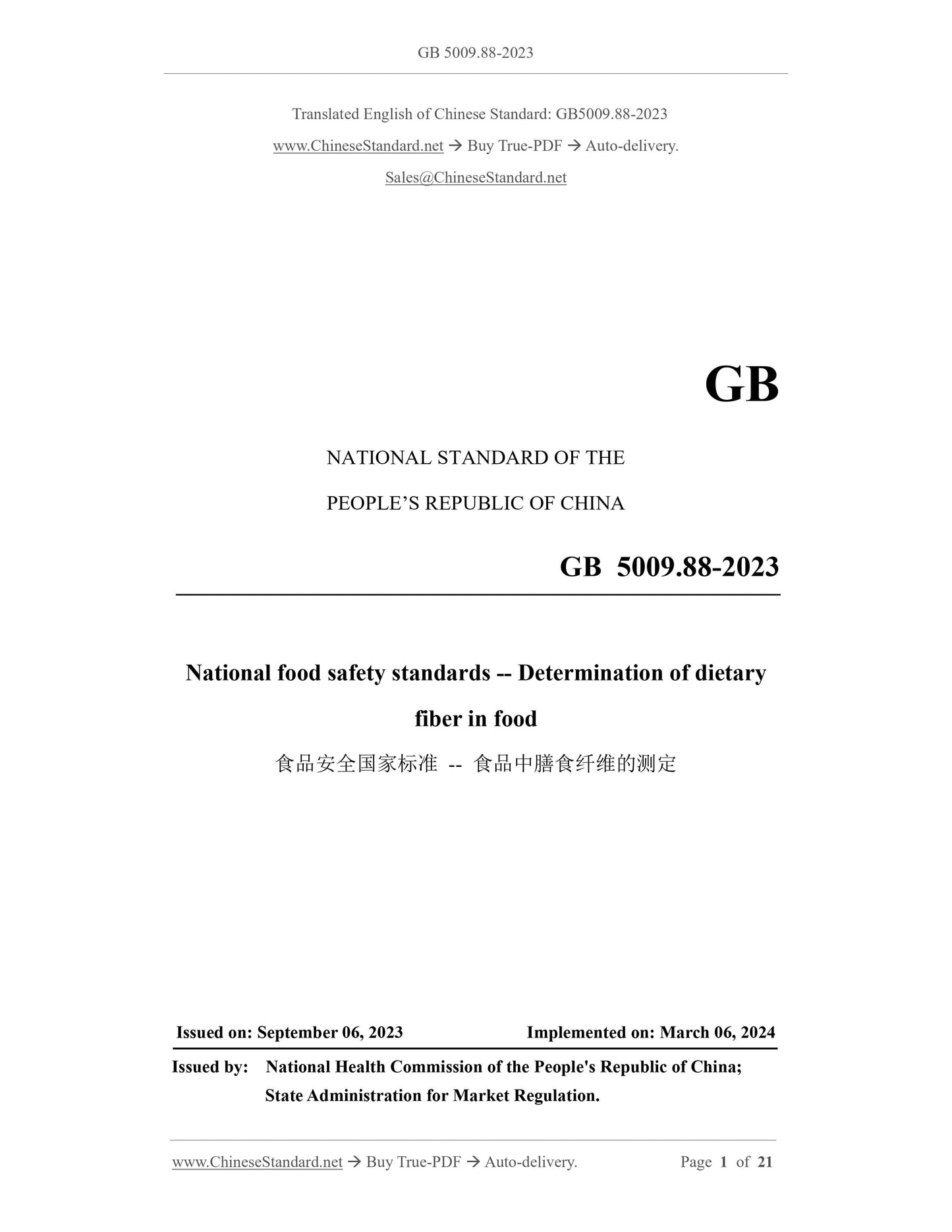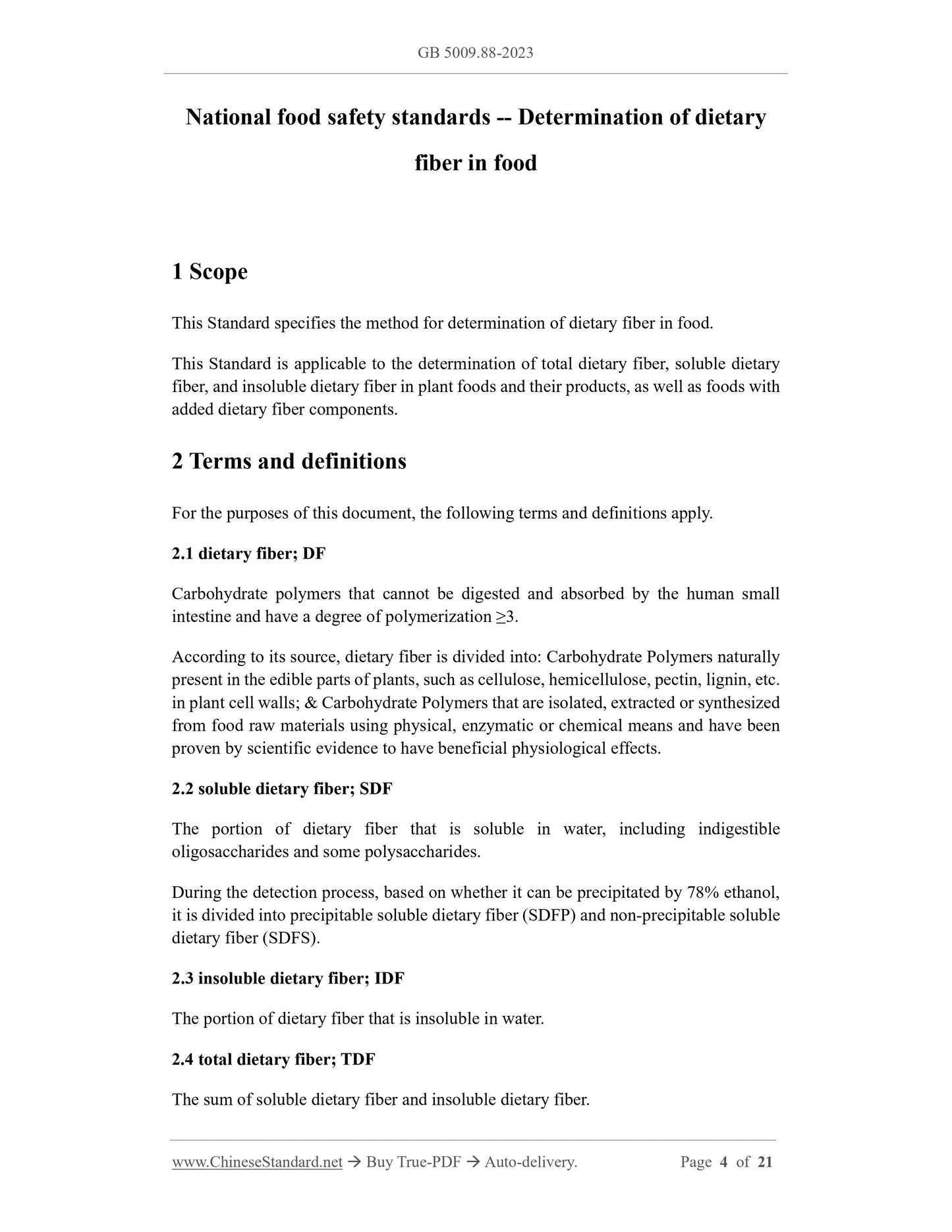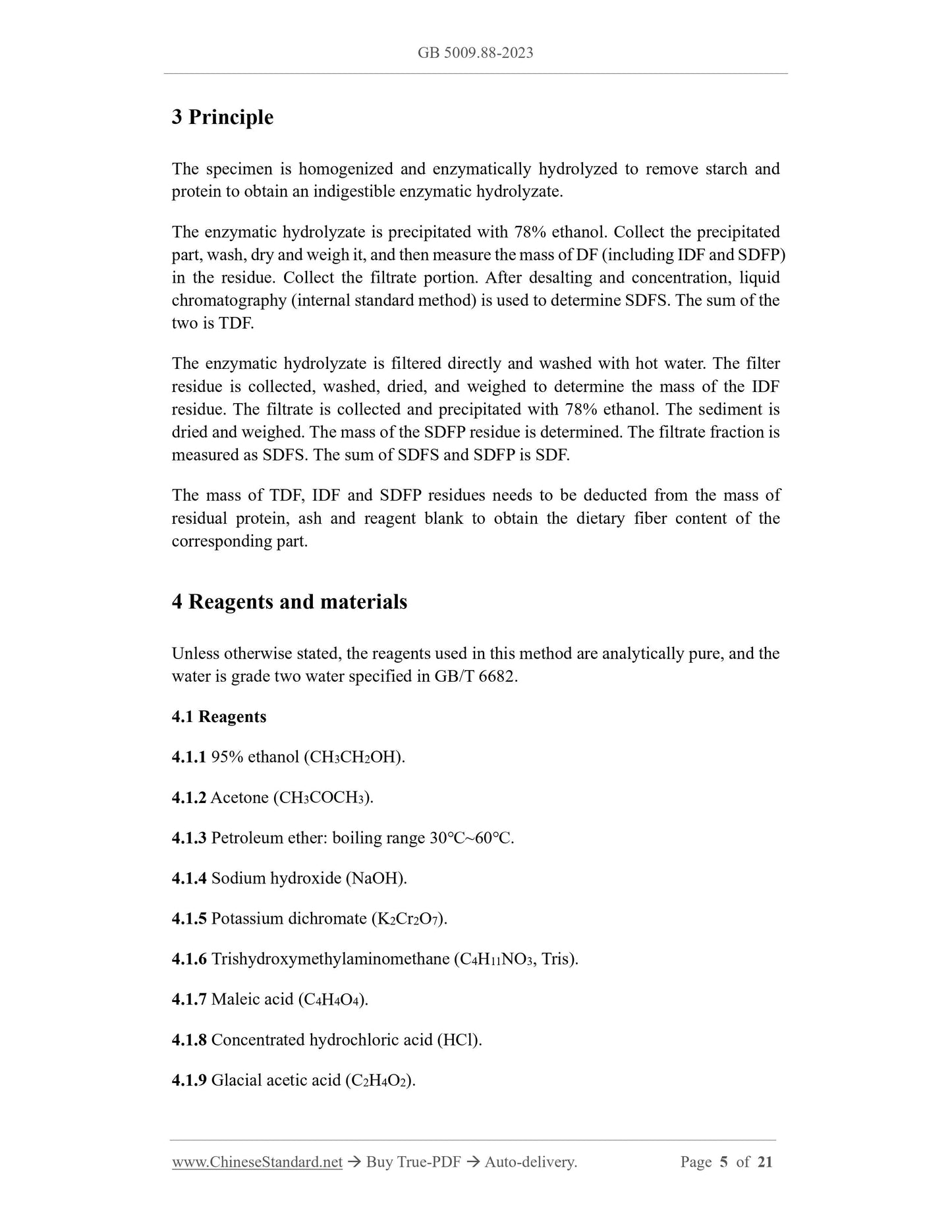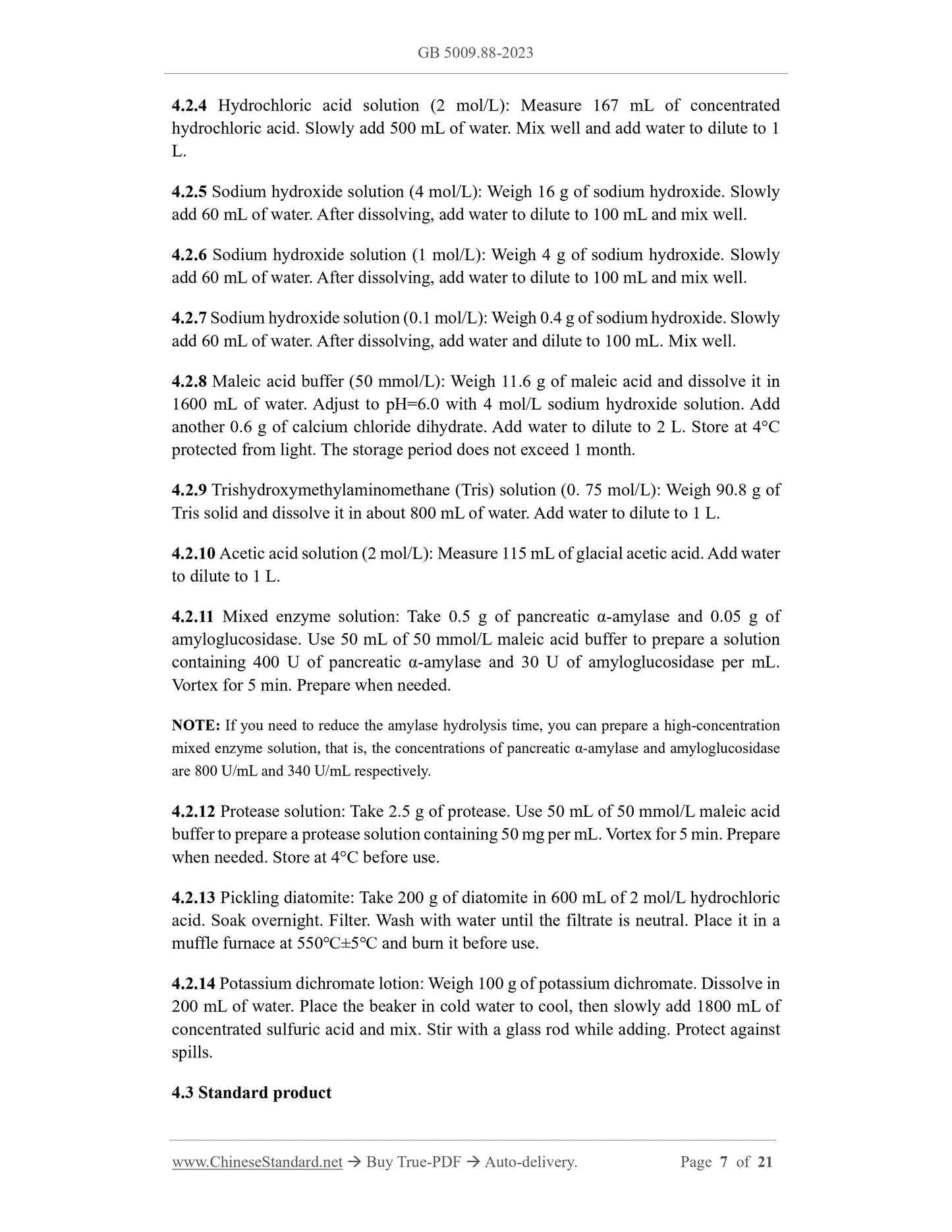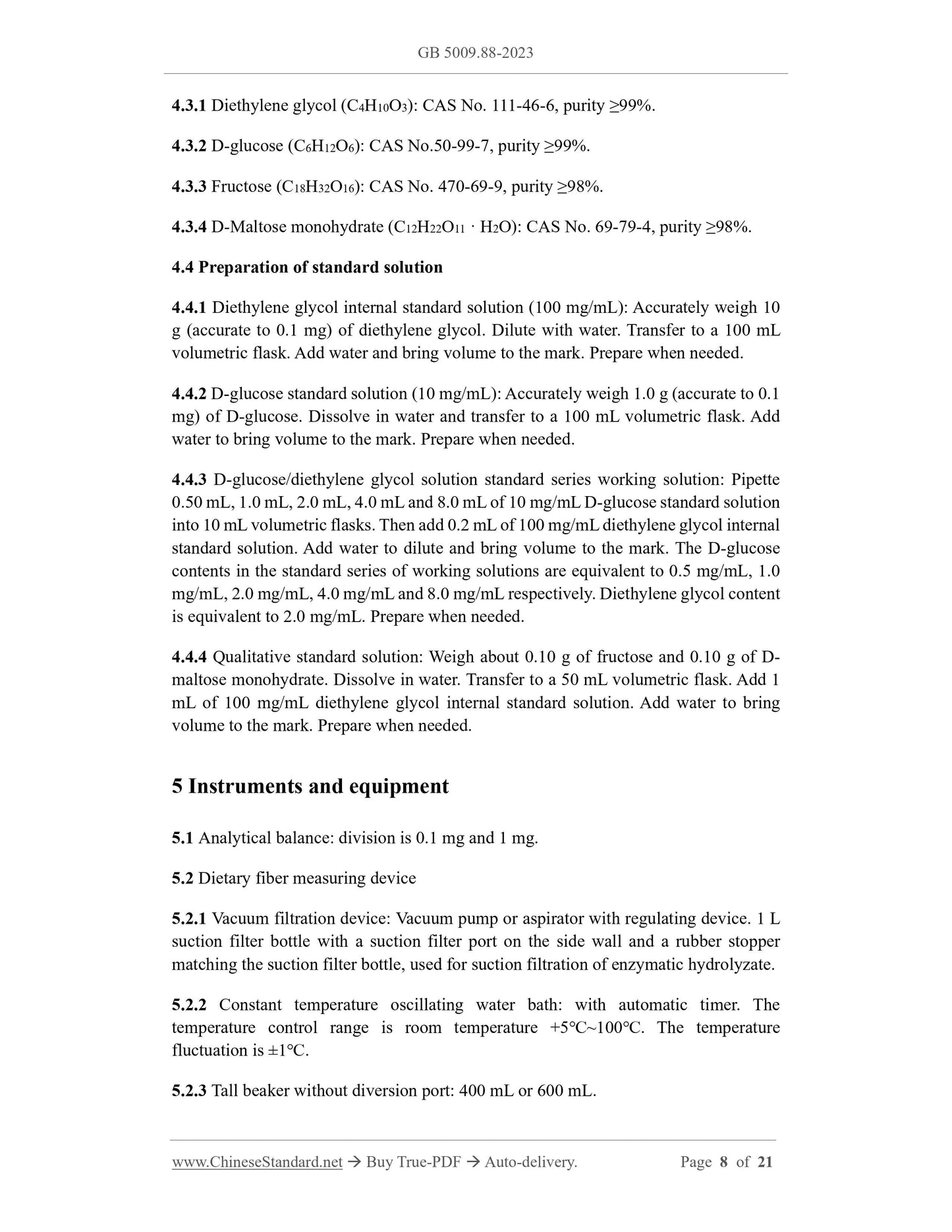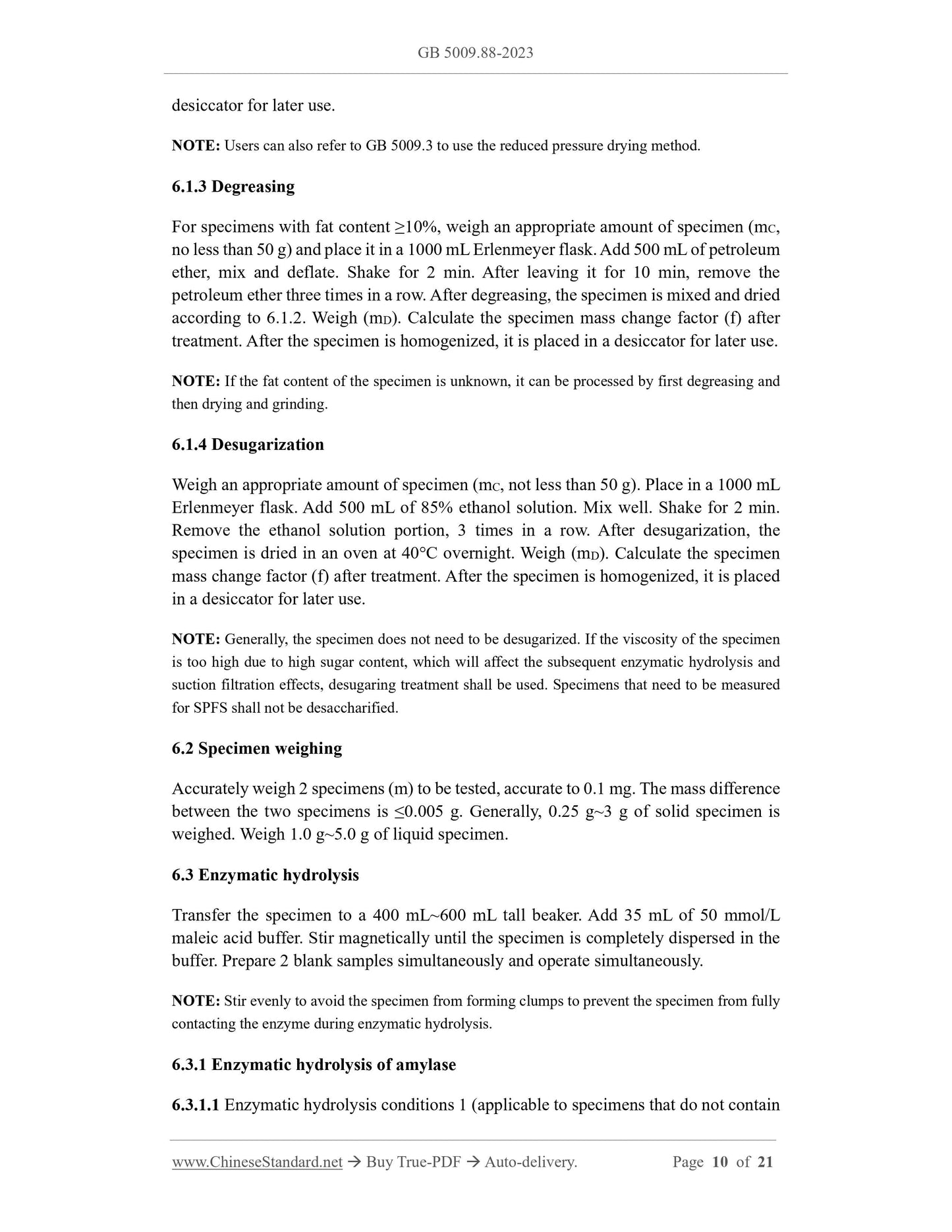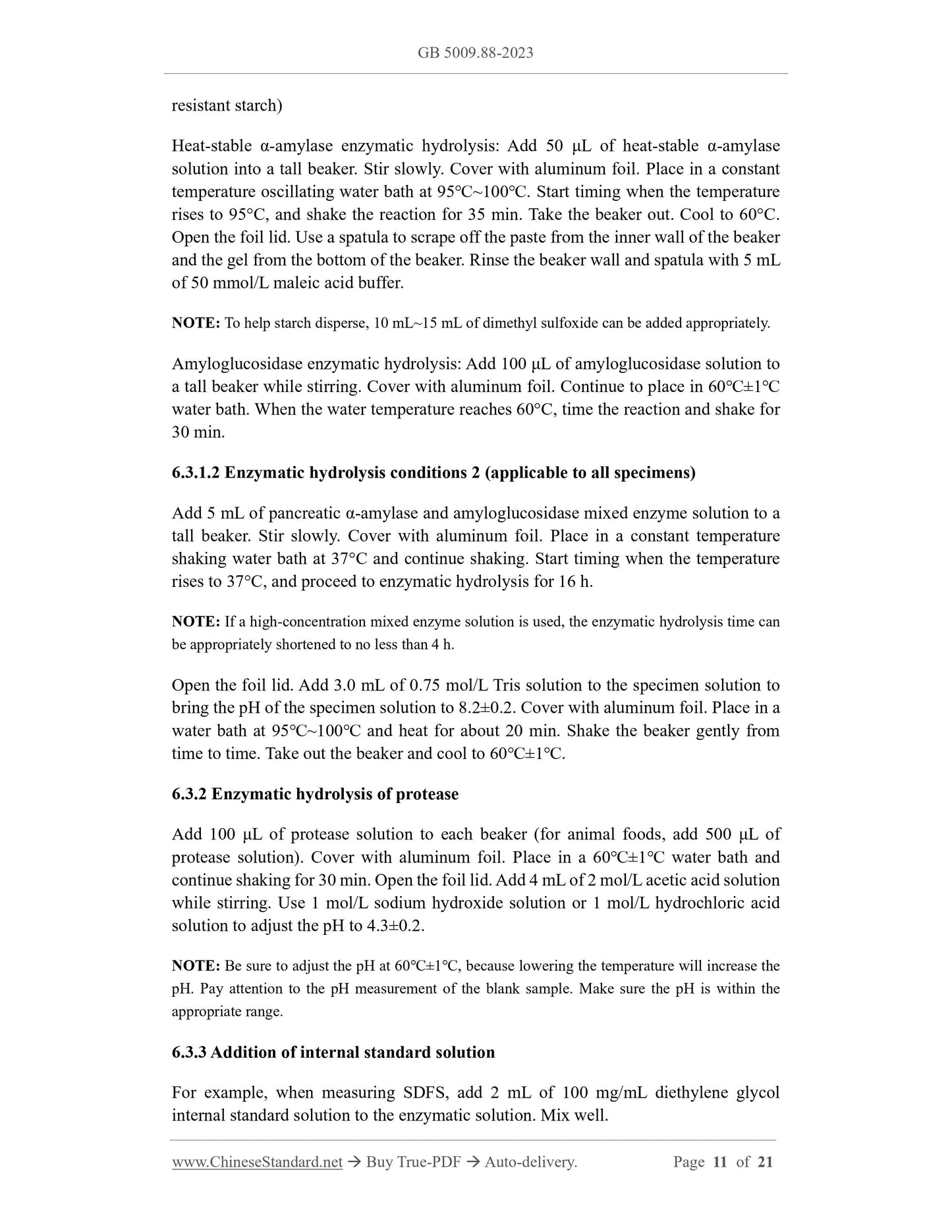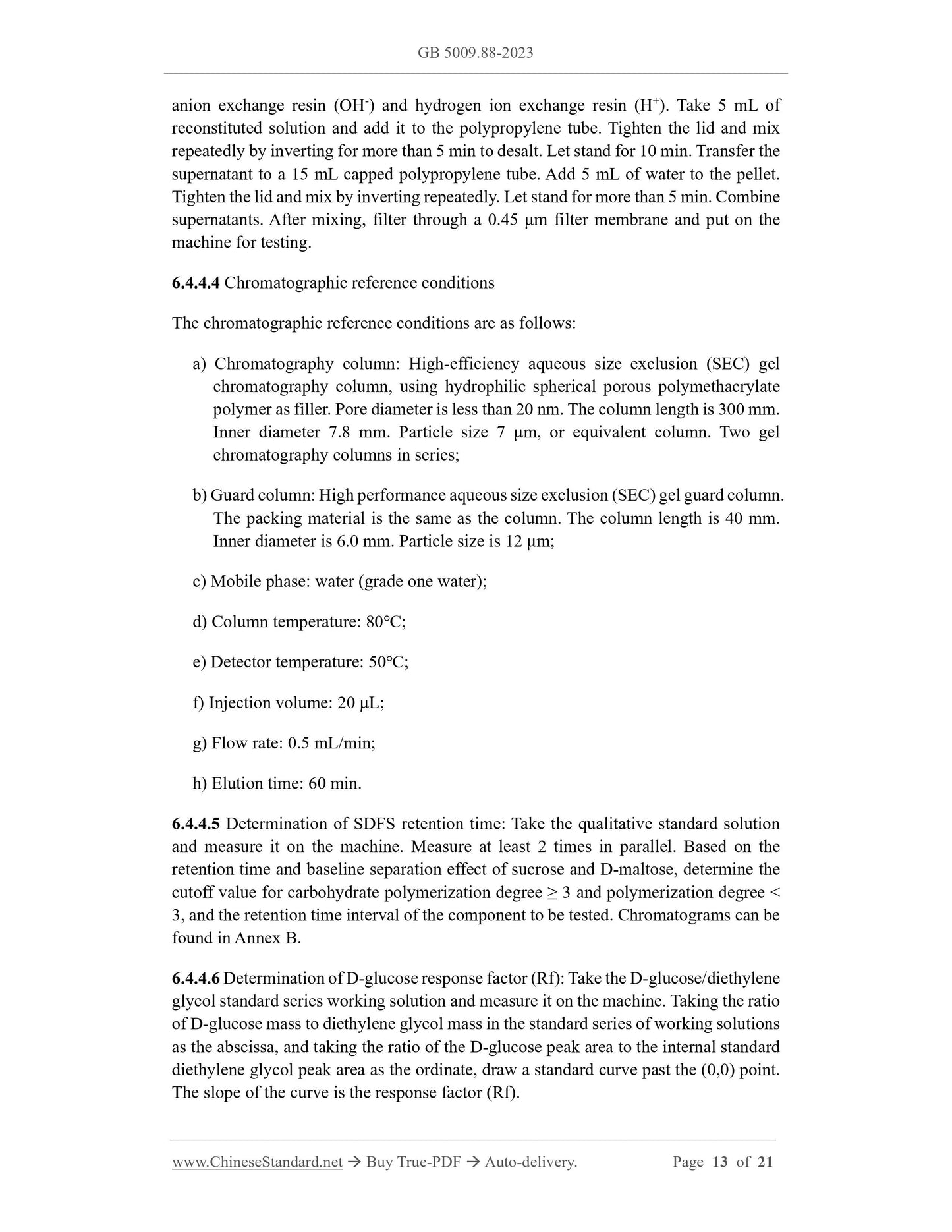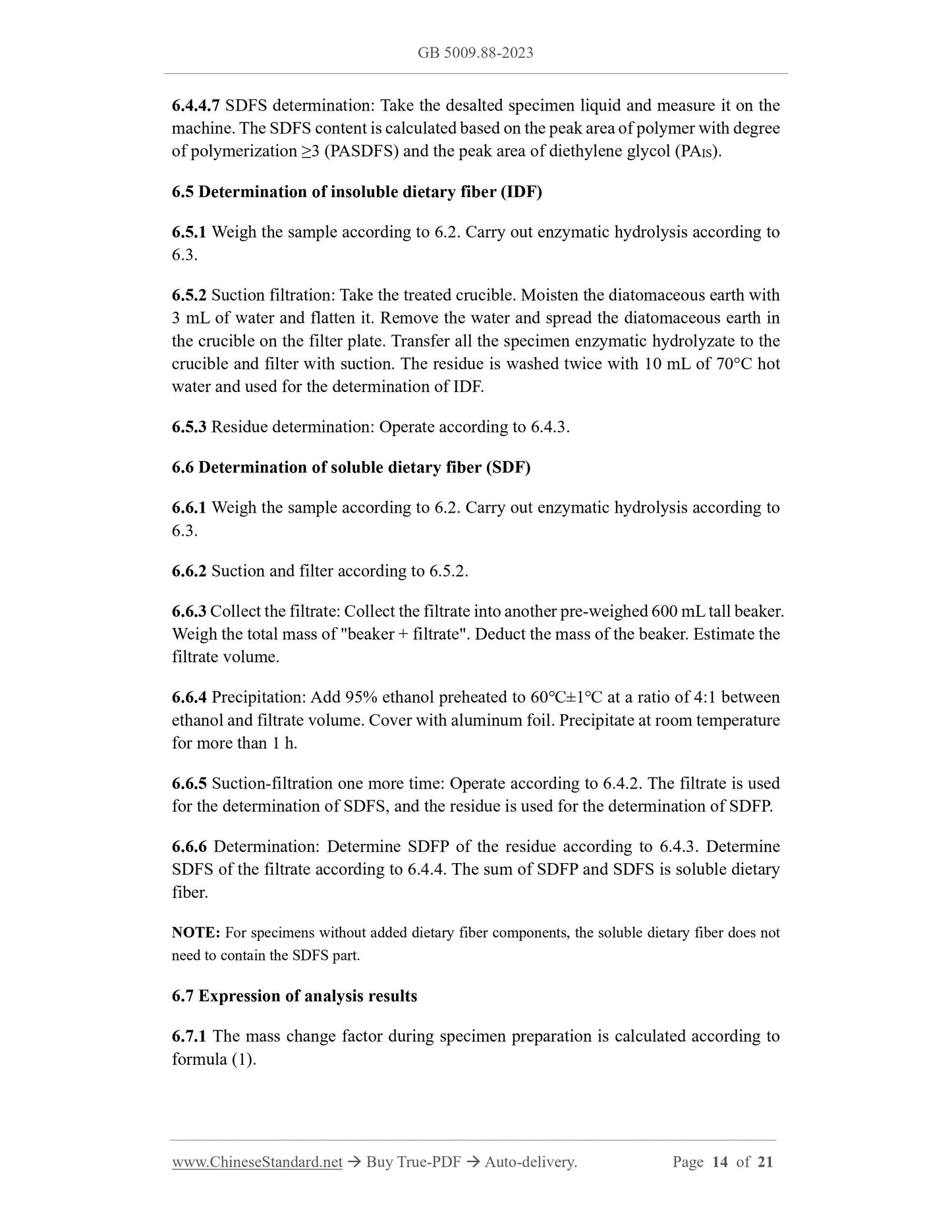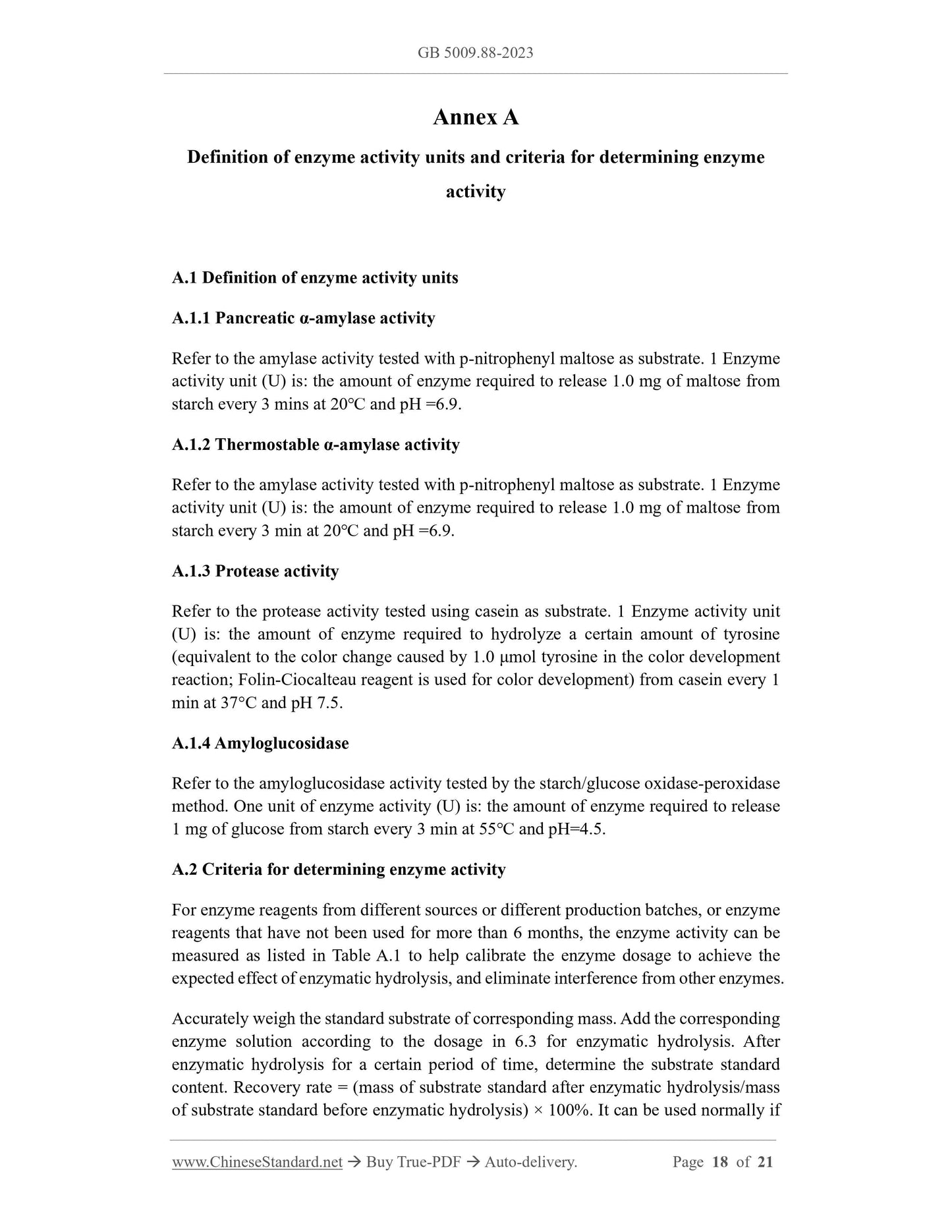1
/
of
11
www.ChineseStandard.us -- Field Test Asia Pte. Ltd.
GB 5009.88-2023 English PDF
GB 5009.88-2023 English PDF
Regular price
$230.00
Regular price
Sale price
$230.00
Unit price
/
per
Shipping calculated at checkout.
Couldn't load pickup availability
GB 5009.88-2023: National food safety standard - Determination of dietary fiber in foods
Delivery: 9 seconds. Download (& Email) true-PDF + Invoice.
Get Quotation: Click GB 5009.88-2023 (Self-service in 1-minute)
Historical versions (Master-website): GB 5009.88-2023
Preview True-PDF (Reload/Scroll-down if blank)
GB 5009.88-2023
GB
NATIONAL STANDARD OF THE
PEOPLE’S REPUBLIC OF CHINA
National food safety standards -- Determination of dietary
fiber in food
ISSUED ON. SEPTEMBER 06, 2023
IMPLEMENTED ON. MARCH 06, 2024
Issued by. National Health Commission of the People's Republic of China;
State Administration for Market Regulation.
Table of Contents
Foreword... 3
1 Scope... 4
2 Terms and definitions... 4
3 Principle... 5
4 Reagents and materials... 5
5 Instruments and equipment... 8
6 Analysis steps... 9
Annex A Definition of enzyme activity units and criteria for determining enzyme
activity... 18
Annex B Chromatogram of dietary fiber... 20
National food safety standards -- Determination of dietary
fiber in food
1 Scope
This Standard specifies the method for determination of dietary fiber in food.
This Standard is applicable to the determination of total dietary fiber, soluble dietary
fiber, and insoluble dietary fiber in plant foods and their products, as well as foods with
added dietary fiber components.
2 Terms and definitions
For the purposes of this document, the following terms and definitions apply.
2.1 dietary fiber; DF
Carbohydrate polymers that cannot be digested and absorbed by the human small
intestine and have a degree of polymerization ≥3.
According to its source, dietary fiber is divided into. Carbohydrate Polymers naturally
present in the edible parts of plants, such as cellulose, hemicellulose, pectin, lignin, etc.
in plant cell walls; and Carbohydrate Polymers that are isolated, extracted or synthesized
from food raw materials using physical, enzymatic or chemical means and have been
proven by scientific evidence to have beneficial physiological effects.
2.2 soluble dietary fiber; SDF
The portion of dietary fiber that is soluble in water, including indigestible
oligosaccharides and some polysaccharides.
During the detection process, based on whether it can be precipitated by 78% ethanol,
it is divided into precipitable soluble dietary fiber (SDFP) and non-precipitable soluble
dietary fiber (SDFS).
2.3 insoluble dietary fiber; IDF
The portion of dietary fiber that is insoluble in water.
2.4 total dietary fiber; TDF
The sum of soluble dietary fiber and insoluble dietary fiber.
3 Principle
The specimen is homogenized and enzymatically hydrolyzed to remove starch and
protein to obtain an indigestible enzymatic hydrolyzate.
The enzymatic hydrolyzate is precipitated with 78% ethanol. Collect the precipitated
part, wash, dry and weigh it, and then measure the mass of DF (including IDF and SDFP)
in the residue. Collect the filtrate portion. After desalting and concentration, liquid
chromatography (internal standard method) is used to determine SDFS. The sum of the
two is TDF.
The enzymatic hydrolyzate is filtered directly and washed with hot water. The filter
residue is collected, washed, dried, and weighed to determine the mass of the IDF
residue. The filtrate is collected and precipitated with 78% ethanol. The sediment is
dried and weighed. The mass of the SDFP residue is determined. The filtrate fraction is
measured as SDFS. The sum of SDFS and SDFP is SDF.
The mass of TDF, IDF and SDFP residues needs to be deducted from the mass of
residual protein, ash and reagent blank to obtain the dietary fiber content of the
corresponding part.
4 Reagents and materials
Unless otherwise stated, the reagents used in this method are analytically pure, and the
water is grade two water specified in GB/T 6682.
4.1 Reagents
4.1.1 95% ethanol (CH3CH2OH).
4.1.2 Acetone (CH3COCH3).
4.1.3 Petroleum ether. boiling range 30℃~60℃.
4.1.4 Sodium hydroxide (NaOH).
4.1.5 Potassium dichromate (K2Cr2O7).
4.1.6 Trishydroxymethylaminomethane (C4H11NO3, Tris).
4.1.7 Maleic acid (C4H4O4).
4.1.8 Concentrated hydrochloric acid (HCl).
4.1.9 Glacial acetic acid (C2H4O2).
4.2.4 Hydrochloric acid solution (2 mol/L). Measure 167 mL of concentrated
hydrochloric acid. Slowly add 500 mL of water. Mix well and add water to dilute to 1
L.
4.2.5 Sodium hydroxide solution (4 mol/L). Weigh 16 g of sodium hydroxide. Slowly
add 60 mL of water. After dissolving, add water to dilute to 100 mL and mix well.
4.2.6 Sodium hydroxide solution (1 mol/L). Weigh 4 g of sodium hydroxide. Slowly
add 60 mL of water. After dissolving, add water to dilute to 100 mL and mix well.
4.2.7 Sodium hydroxide solution (0.1 mol/L). Weigh 0.4 g of sodium hydroxide. Slowly
add 60 mL of water. After dissolving, add water and dilute to 100 mL. Mix well.
4.2.8 Maleic acid buffer (50 mmol/L). Weigh 11.6 g of maleic acid and dissolve it in
1600 mL of water. Adjust to pH=6.0 with 4 mol/L sodium hydroxide solution. Add
another 0.6 g of calcium chloride dihydrate. Add water to dilute to 2 L. Store at 4°C
protected from light. The storage period does not exceed 1 month.
4.2.9 Trishydroxymethylaminomethane (Tris) solution (0.75 mol/L). Weigh 90.8 g of
Tris solid and dissolve it in about 800 mL of water. Add water to dilute to 1 L.
4.2.10 Acetic acid solution (2 mol/L). Measure 115 mL of glacial acetic acid. Add water
to dilute to 1 L.
4.2.11 Mixed enzyme solution. Take 0.5 g of pancreatic α-amylase and 0.05 g of
amyloglucosidase. Use 50 mL of 50 mmol/L maleic acid buffer to prepare a solution
containing 400 U of pancreatic α-amylase and 30 U of amyloglucosidase per mL.
Vortex for 5 min. Prepare when needed.
NOTE. If you need to reduce the amylase hydrolysis time, you can prepare a high-concentration
mixed enzyme solution, that is, the concentrations of pancreatic α-amylase and amyloglucosidase
are 800 U/mL and 340 U/mL respectively.
4.2.12 Protease solution. Take 2.5 g of protease. Use 50 mL of 50 mmol/L maleic acid
buffer to prepare a protease solution containing 50 mg per mL. Vortex for 5 min. Prepare
when needed. Store at 4°C before use.
4.2.13 Pickling diatomite. Take 200 g of diatomite in 600 mL of 2 mol/L hydrochloric
acid. Soak overnight. Filter. Wash with water until the filtrate is neutral. Place it in a
muffle furnace at 550℃±5℃ and burn it before use.
4.2.14 Potassium dichromate lotion. Weigh 100 g of potassium dichromate. Dissolve in
200 mL of water. Place the beaker in cold water to cool, then slowly add 1800 mL of
concentrated sulfuric acid and mix. Stir with a glass rod while adding. Protect against
spills.
4.3 Standard product
4.3.1 Diethylene glycol (C4H10O3). CAS No. 111-46-6, purity ≥99%.
4.3.2 D-glucose (C6H12O6). CAS No.50-99-7, purity ≥99%.
4.3.3 Fructose (C18H32O16). CAS No. 470-69-9, purity ≥98%.
4.3.4 D-Maltose monohydrate (C12H22O11 · H2O). CAS No. 69-79-4, purity ≥98%.
4.4 Preparation of standard solution
4.4.1 Diethylene glycol internal standard solution (100 mg/mL). Accurately weigh 10
g (accurate to 0.1 mg) of diethylene glycol. Dilute with water. Transfer to a 100 mL
volumetric flask. Add water and bring volume to the mark. Prepare when needed.
4.4.2 D-glucose standard solution (10 mg/mL). Accurately weigh 1.0 g (accurate to 0.1
mg) of D-glucose. Dissolve in water and transfer to a 100 mL volumetric flask. Add
water to bring volume to the mark. Prepare when needed.
4.4.3 D-glucose/diethylene glycol solution standard series working solution. Pipette
0.50 mL, 1.0 mL, 2.0 mL, 4.0 mL and 8.0 mL of 10 mg/mL D-glucose standard solution
into 10 mL volumetric flasks. Then add 0.2 mL of 100 mg/mL diethylene glycol internal
standard solution. Add water to dilute and bring volume to the mark. The D-glucose
contents in the standard series of working solutions are equivalent to 0.5 mg/mL, 1.0
mg/mL, 2.0 mg/mL, 4.0 mg/mL and 8.0 mg/mL respectively. Diethylene glycol content
is equivalent to 2.0 mg/mL. Prepare when needed.
4.4.4 Qualitative standard solution. Weigh about 0.10 g of fructose and 0.10 g of D-
maltose monohydrate. Dissolve in water. Transfer to a 50 mL volumetric flask. Add 1
mL of 100 mg/mL diethylene glycol internal standard solution. Add water to bring
volume to the mark. Prepare when needed.
5 Instruments and equipment
5.1 Analytical balance. division is 0.1 mg and 1 mg.
5.2 Dietary fiber measuring device
5.2.1 Vacuum filtration device. Vacuum pump or aspirator with regulating device. 1 L
suction filter bottle with a suction filter port on the side wall and a rubber stopper
matching the suction filter bottle, used for suction filtration of enzymatic hydrolyzate.
5.2.2 Constant temperature oscillating water bath. with automatic timer. The
temperature control range is room temperature +5℃~100℃. The temperature
fluctuation is ±1℃.
5.2.3 Tall beaker without diversion port. 400 mL or 600 mL.
desiccator for later use.
NOTE. Users can also refer to GB 5009.3 to use the reduced pressure drying method.
6.1.3 Degreasing
For specimens with fat content ≥10%, weigh an appropriate amount of specimen (mC,
no less than 50 g) and place it in a 1000 mL Erlenmeyer flask. Add 500 mL of petroleum
ether, mix and deflate. Shake for 2 min. After leaving it for 10 min, remove the
petroleum ether three times in a row. After degreasing, the specimen is mixed and dried
according to 6.1.2.Weigh (mD). Calculate the specimen mass change factor (f) after
treatment. After the specimen is homogenized, it is placed in a desiccator for later use.
NOTE. If the fat content of the specimen is unknown, it can be processed by first degreasing and
then drying and grinding.
6.1.4 Desugarization
Weigh an appropriate amount of specimen (mC, not less than 50 g). Place in a 1000 mL
Erlenmeyer flask. Add 500 mL of 85% ethanol solution. Mix well. Shake for 2 min.
Remove the ethanol solution portion, 3 times in a row. After desugarization, the
specimen is dried in an oven at 40°C overnight. Weigh (mD). Calculate the specimen
mass change factor (f) after treatment. After the specimen is homogenized, it is placed
in a desiccator for later use.
NOTE. Generally, the specimen does not need to be desugarized. If the viscosity of the specimen
is too high due to high sugar content, which will affect the subsequent enzymatic hydrolysis and
suction filtration effects, desugaring treatment shall be used. Specimens that need to be measured
for SPFS shall not be desaccharified.
6.2 Specimen weighing
Accurately weigh 2 specimens (m) to be tested, accurate to 0.1 mg. The mass difference
between the two specimens is ≤0.005 g. Generally, 0.25 g~3 g of solid specimen is
weighed. Weigh 1.0 g~5.0 g of liquid specimen.
6.3 Enzymatic hydrolysis
Transfer the specimen to a 400 mL~600 mL tall beaker. Add 35 mL of 50 mmol/L
maleic acid buffer. Stir magnetically until the specimen is completely dispersed in the
buffer. Prepare 2 blank samples simultaneously and operate simultaneously.
NOTE. Stir evenly to avoid the specimen from forming clumps to prevent the specimen from fully
contacting the enzyme during enzymatic hydrolysis.
6.3.1 Enzymatic hydrolysis of amylase
6.3.1.1 Enzymatic hydrolysis conditions 1 (applicable to specimens that do not contain
resistant starch)
Heat-stable α-amylase enzymatic hydrolysis. Add 50 μL of heat-stable α-amylase
solution into a tall beaker. Stir slowly. Cover with aluminum foil. Place in a constant
temperature oscillating water bath at 95℃~100℃. Start timing when the temperature
rises to 95°C, and shake the reaction for 35 min. Take the beaker out. Cool to 60°C.
Open the foil lid. Use a spatula to scrape off the paste from the inner wall of the beaker
and the gel from the bottom of the beaker. Rinse the beaker wall and spatula with 5 mL
of 50 mmol/L maleic acid buffer.
NOTE. To help starch disperse, 10 mL~15 mL of dimethyl sulfoxide can be added appropriately.
Amyloglucosidase enzymatic hydrolysis. Add 100 μL of amyloglucosidase solution to
a tall beaker while stirring. Cover with aluminum foil. Continue to place in 60℃±1℃
water bath. When the water temperature reaches 60°C, time the reaction and shake for
30 min.
6.3.1.2 Enzymatic hydrolysis conditions 2 (applicable to all specimens)
Add 5 mL of pancreatic α-amylase and amyloglucosidase mixed enzyme solution to a
tall beaker. Stir slowly. Cover with aluminum foil. Place in a constant temperature
shaking water bath at 37°C and continue shaking. Start timing when the temperature
rises to 37°C, and proceed to enzymatic hydrolysis for 16 h.
NOTE. If a high-concentration mixed enzyme solution is used, the enzymatic hydrolysis time can
be appropriately shortened to no less than 4 h.
Open the foil lid. Add 3.0 mL of 0.75 mol/L Tris solution to the specimen solution to
bring the pH of the specimen solution to 8.2±0.2.Cover with aluminum foil. Place in a
water bath at 95℃~100℃ and heat for about 20 min. Shake the beaker gently from
time to time. Take out the beaker and cool to 60℃±1℃.
6.3.2 Enzymatic hydrolysis of protease
Add 100 μL of protease solution to each beaker (for animal foods, add 500 μL of
protease solution). Cover with aluminum foil. Place in a 60℃±1℃ water bath and
continue shaking for 30 min. Open the foil lid. Add 4 mL of 2 mol/L acetic acid solution
while stirring. Use 1 mol/L sodium hydroxide solution or 1 mol/L hydrochloric acid
solution to adjust the pH to 4.3±0.2.
NOTE. Be sure to adjust the pH at 60℃±1℃, because lowering the temperature will increase the
pH. Pay attention to the pH measurement of the blank sample. Make sure the pH is within the
appropriate range.
6.3.3 Addition of internal standard solution
For example, when measuring SDFS, add 2 mL of 100 mg/mL diethylene glycol
internal standard solution to the enzymatic solution. Mix well.
anion exchange resin (OH-) and hydrogen ion exchange resin (H+). Take 5 mL of
reconstituted solution and add it to the polypropylene tube. Tighten the lid and mix
repeatedly by inverting for more than 5 min to desalt. Let stand for 10 min. Transfer the
supernatant to a 15 mL capped polypropylene tube. Add 5 mL of water to the pellet.
Tighten the lid and mix by inverting repeatedly. Let stand for more than 5 min. Combine
supernatants. After mixing, filter through a 0.45 μm filter membrane and put on the
machine for testing.
Delivery: 9 seconds. Download (& Email) true-PDF + Invoice.
Get Quotation: Click GB 5009.88-2023 (Self-service in 1-minute)
Historical versions (Master-website): GB 5009.88-2023
Preview True-PDF (Reload/Scroll-down if blank)
GB 5009.88-2023
GB
NATIONAL STANDARD OF THE
PEOPLE’S REPUBLIC OF CHINA
National food safety standards -- Determination of dietary
fiber in food
ISSUED ON. SEPTEMBER 06, 2023
IMPLEMENTED ON. MARCH 06, 2024
Issued by. National Health Commission of the People's Republic of China;
State Administration for Market Regulation.
Table of Contents
Foreword... 3
1 Scope... 4
2 Terms and definitions... 4
3 Principle... 5
4 Reagents and materials... 5
5 Instruments and equipment... 8
6 Analysis steps... 9
Annex A Definition of enzyme activity units and criteria for determining enzyme
activity... 18
Annex B Chromatogram of dietary fiber... 20
National food safety standards -- Determination of dietary
fiber in food
1 Scope
This Standard specifies the method for determination of dietary fiber in food.
This Standard is applicable to the determination of total dietary fiber, soluble dietary
fiber, and insoluble dietary fiber in plant foods and their products, as well as foods with
added dietary fiber components.
2 Terms and definitions
For the purposes of this document, the following terms and definitions apply.
2.1 dietary fiber; DF
Carbohydrate polymers that cannot be digested and absorbed by the human small
intestine and have a degree of polymerization ≥3.
According to its source, dietary fiber is divided into. Carbohydrate Polymers naturally
present in the edible parts of plants, such as cellulose, hemicellulose, pectin, lignin, etc.
in plant cell walls; and Carbohydrate Polymers that are isolated, extracted or synthesized
from food raw materials using physical, enzymatic or chemical means and have been
proven by scientific evidence to have beneficial physiological effects.
2.2 soluble dietary fiber; SDF
The portion of dietary fiber that is soluble in water, including indigestible
oligosaccharides and some polysaccharides.
During the detection process, based on whether it can be precipitated by 78% ethanol,
it is divided into precipitable soluble dietary fiber (SDFP) and non-precipitable soluble
dietary fiber (SDFS).
2.3 insoluble dietary fiber; IDF
The portion of dietary fiber that is insoluble in water.
2.4 total dietary fiber; TDF
The sum of soluble dietary fiber and insoluble dietary fiber.
3 Principle
The specimen is homogenized and enzymatically hydrolyzed to remove starch and
protein to obtain an indigestible enzymatic hydrolyzate.
The enzymatic hydrolyzate is precipitated with 78% ethanol. Collect the precipitated
part, wash, dry and weigh it, and then measure the mass of DF (including IDF and SDFP)
in the residue. Collect the filtrate portion. After desalting and concentration, liquid
chromatography (internal standard method) is used to determine SDFS. The sum of the
two is TDF.
The enzymatic hydrolyzate is filtered directly and washed with hot water. The filter
residue is collected, washed, dried, and weighed to determine the mass of the IDF
residue. The filtrate is collected and precipitated with 78% ethanol. The sediment is
dried and weighed. The mass of the SDFP residue is determined. The filtrate fraction is
measured as SDFS. The sum of SDFS and SDFP is SDF.
The mass of TDF, IDF and SDFP residues needs to be deducted from the mass of
residual protein, ash and reagent blank to obtain the dietary fiber content of the
corresponding part.
4 Reagents and materials
Unless otherwise stated, the reagents used in this method are analytically pure, and the
water is grade two water specified in GB/T 6682.
4.1 Reagents
4.1.1 95% ethanol (CH3CH2OH).
4.1.2 Acetone (CH3COCH3).
4.1.3 Petroleum ether. boiling range 30℃~60℃.
4.1.4 Sodium hydroxide (NaOH).
4.1.5 Potassium dichromate (K2Cr2O7).
4.1.6 Trishydroxymethylaminomethane (C4H11NO3, Tris).
4.1.7 Maleic acid (C4H4O4).
4.1.8 Concentrated hydrochloric acid (HCl).
4.1.9 Glacial acetic acid (C2H4O2).
4.2.4 Hydrochloric acid solution (2 mol/L). Measure 167 mL of concentrated
hydrochloric acid. Slowly add 500 mL of water. Mix well and add water to dilute to 1
L.
4.2.5 Sodium hydroxide solution (4 mol/L). Weigh 16 g of sodium hydroxide. Slowly
add 60 mL of water. After dissolving, add water to dilute to 100 mL and mix well.
4.2.6 Sodium hydroxide solution (1 mol/L). Weigh 4 g of sodium hydroxide. Slowly
add 60 mL of water. After dissolving, add water to dilute to 100 mL and mix well.
4.2.7 Sodium hydroxide solution (0.1 mol/L). Weigh 0.4 g of sodium hydroxide. Slowly
add 60 mL of water. After dissolving, add water and dilute to 100 mL. Mix well.
4.2.8 Maleic acid buffer (50 mmol/L). Weigh 11.6 g of maleic acid and dissolve it in
1600 mL of water. Adjust to pH=6.0 with 4 mol/L sodium hydroxide solution. Add
another 0.6 g of calcium chloride dihydrate. Add water to dilute to 2 L. Store at 4°C
protected from light. The storage period does not exceed 1 month.
4.2.9 Trishydroxymethylaminomethane (Tris) solution (0.75 mol/L). Weigh 90.8 g of
Tris solid and dissolve it in about 800 mL of water. Add water to dilute to 1 L.
4.2.10 Acetic acid solution (2 mol/L). Measure 115 mL of glacial acetic acid. Add water
to dilute to 1 L.
4.2.11 Mixed enzyme solution. Take 0.5 g of pancreatic α-amylase and 0.05 g of
amyloglucosidase. Use 50 mL of 50 mmol/L maleic acid buffer to prepare a solution
containing 400 U of pancreatic α-amylase and 30 U of amyloglucosidase per mL.
Vortex for 5 min. Prepare when needed.
NOTE. If you need to reduce the amylase hydrolysis time, you can prepare a high-concentration
mixed enzyme solution, that is, the concentrations of pancreatic α-amylase and amyloglucosidase
are 800 U/mL and 340 U/mL respectively.
4.2.12 Protease solution. Take 2.5 g of protease. Use 50 mL of 50 mmol/L maleic acid
buffer to prepare a protease solution containing 50 mg per mL. Vortex for 5 min. Prepare
when needed. Store at 4°C before use.
4.2.13 Pickling diatomite. Take 200 g of diatomite in 600 mL of 2 mol/L hydrochloric
acid. Soak overnight. Filter. Wash with water until the filtrate is neutral. Place it in a
muffle furnace at 550℃±5℃ and burn it before use.
4.2.14 Potassium dichromate lotion. Weigh 100 g of potassium dichromate. Dissolve in
200 mL of water. Place the beaker in cold water to cool, then slowly add 1800 mL of
concentrated sulfuric acid and mix. Stir with a glass rod while adding. Protect against
spills.
4.3 Standard product
4.3.1 Diethylene glycol (C4H10O3). CAS No. 111-46-6, purity ≥99%.
4.3.2 D-glucose (C6H12O6). CAS No.50-99-7, purity ≥99%.
4.3.3 Fructose (C18H32O16). CAS No. 470-69-9, purity ≥98%.
4.3.4 D-Maltose monohydrate (C12H22O11 · H2O). CAS No. 69-79-4, purity ≥98%.
4.4 Preparation of standard solution
4.4.1 Diethylene glycol internal standard solution (100 mg/mL). Accurately weigh 10
g (accurate to 0.1 mg) of diethylene glycol. Dilute with water. Transfer to a 100 mL
volumetric flask. Add water and bring volume to the mark. Prepare when needed.
4.4.2 D-glucose standard solution (10 mg/mL). Accurately weigh 1.0 g (accurate to 0.1
mg) of D-glucose. Dissolve in water and transfer to a 100 mL volumetric flask. Add
water to bring volume to the mark. Prepare when needed.
4.4.3 D-glucose/diethylene glycol solution standard series working solution. Pipette
0.50 mL, 1.0 mL, 2.0 mL, 4.0 mL and 8.0 mL of 10 mg/mL D-glucose standard solution
into 10 mL volumetric flasks. Then add 0.2 mL of 100 mg/mL diethylene glycol internal
standard solution. Add water to dilute and bring volume to the mark. The D-glucose
contents in the standard series of working solutions are equivalent to 0.5 mg/mL, 1.0
mg/mL, 2.0 mg/mL, 4.0 mg/mL and 8.0 mg/mL respectively. Diethylene glycol content
is equivalent to 2.0 mg/mL. Prepare when needed.
4.4.4 Qualitative standard solution. Weigh about 0.10 g of fructose and 0.10 g of D-
maltose monohydrate. Dissolve in water. Transfer to a 50 mL volumetric flask. Add 1
mL of 100 mg/mL diethylene glycol internal standard solution. Add water to bring
volume to the mark. Prepare when needed.
5 Instruments and equipment
5.1 Analytical balance. division is 0.1 mg and 1 mg.
5.2 Dietary fiber measuring device
5.2.1 Vacuum filtration device. Vacuum pump or aspirator with regulating device. 1 L
suction filter bottle with a suction filter port on the side wall and a rubber stopper
matching the suction filter bottle, used for suction filtration of enzymatic hydrolyzate.
5.2.2 Constant temperature oscillating water bath. with automatic timer. The
temperature control range is room temperature +5℃~100℃. The temperature
fluctuation is ±1℃.
5.2.3 Tall beaker without diversion port. 400 mL or 600 mL.
desiccator for later use.
NOTE. Users can also refer to GB 5009.3 to use the reduced pressure drying method.
6.1.3 Degreasing
For specimens with fat content ≥10%, weigh an appropriate amount of specimen (mC,
no less than 50 g) and place it in a 1000 mL Erlenmeyer flask. Add 500 mL of petroleum
ether, mix and deflate. Shake for 2 min. After leaving it for 10 min, remove the
petroleum ether three times in a row. After degreasing, the specimen is mixed and dried
according to 6.1.2.Weigh (mD). Calculate the specimen mass change factor (f) after
treatment. After the specimen is homogenized, it is placed in a desiccator for later use.
NOTE. If the fat content of the specimen is unknown, it can be processed by first degreasing and
then drying and grinding.
6.1.4 Desugarization
Weigh an appropriate amount of specimen (mC, not less than 50 g). Place in a 1000 mL
Erlenmeyer flask. Add 500 mL of 85% ethanol solution. Mix well. Shake for 2 min.
Remove the ethanol solution portion, 3 times in a row. After desugarization, the
specimen is dried in an oven at 40°C overnight. Weigh (mD). Calculate the specimen
mass change factor (f) after treatment. After the specimen is homogenized, it is placed
in a desiccator for later use.
NOTE. Generally, the specimen does not need to be desugarized. If the viscosity of the specimen
is too high due to high sugar content, which will affect the subsequent enzymatic hydrolysis and
suction filtration effects, desugaring treatment shall be used. Specimens that need to be measured
for SPFS shall not be desaccharified.
6.2 Specimen weighing
Accurately weigh 2 specimens (m) to be tested, accurate to 0.1 mg. The mass difference
between the two specimens is ≤0.005 g. Generally, 0.25 g~3 g of solid specimen is
weighed. Weigh 1.0 g~5.0 g of liquid specimen.
6.3 Enzymatic hydrolysis
Transfer the specimen to a 400 mL~600 mL tall beaker. Add 35 mL of 50 mmol/L
maleic acid buffer. Stir magnetically until the specimen is completely dispersed in the
buffer. Prepare 2 blank samples simultaneously and operate simultaneously.
NOTE. Stir evenly to avoid the specimen from forming clumps to prevent the specimen from fully
contacting the enzyme during enzymatic hydrolysis.
6.3.1 Enzymatic hydrolysis of amylase
6.3.1.1 Enzymatic hydrolysis conditions 1 (applicable to specimens that do not contain
resistant starch)
Heat-stable α-amylase enzymatic hydrolysis. Add 50 μL of heat-stable α-amylase
solution into a tall beaker. Stir slowly. Cover with aluminum foil. Place in a constant
temperature oscillating water bath at 95℃~100℃. Start timing when the temperature
rises to 95°C, and shake the reaction for 35 min. Take the beaker out. Cool to 60°C.
Open the foil lid. Use a spatula to scrape off the paste from the inner wall of the beaker
and the gel from the bottom of the beaker. Rinse the beaker wall and spatula with 5 mL
of 50 mmol/L maleic acid buffer.
NOTE. To help starch disperse, 10 mL~15 mL of dimethyl sulfoxide can be added appropriately.
Amyloglucosidase enzymatic hydrolysis. Add 100 μL of amyloglucosidase solution to
a tall beaker while stirring. Cover with aluminum foil. Continue to place in 60℃±1℃
water bath. When the water temperature reaches 60°C, time the reaction and shake for
30 min.
6.3.1.2 Enzymatic hydrolysis conditions 2 (applicable to all specimens)
Add 5 mL of pancreatic α-amylase and amyloglucosidase mixed enzyme solution to a
tall beaker. Stir slowly. Cover with aluminum foil. Place in a constant temperature
shaking water bath at 37°C and continue shaking. Start timing when the temperature
rises to 37°C, and proceed to enzymatic hydrolysis for 16 h.
NOTE. If a high-concentration mixed enzyme solution is used, the enzymatic hydrolysis time can
be appropriately shortened to no less than 4 h.
Open the foil lid. Add 3.0 mL of 0.75 mol/L Tris solution to the specimen solution to
bring the pH of the specimen solution to 8.2±0.2.Cover with aluminum foil. Place in a
water bath at 95℃~100℃ and heat for about 20 min. Shake the beaker gently from
time to time. Take out the beaker and cool to 60℃±1℃.
6.3.2 Enzymatic hydrolysis of protease
Add 100 μL of protease solution to each beaker (for animal foods, add 500 μL of
protease solution). Cover with aluminum foil. Place in a 60℃±1℃ water bath and
continue shaking for 30 min. Open the foil lid. Add 4 mL of 2 mol/L acetic acid solution
while stirring. Use 1 mol/L sodium hydroxide solution or 1 mol/L hydrochloric acid
solution to adjust the pH to 4.3±0.2.
NOTE. Be sure to adjust the pH at 60℃±1℃, because lowering the temperature will increase the
pH. Pay attention to the pH measurement of the blank sample. Make sure the pH is within the
appropriate range.
6.3.3 Addition of internal standard solution
For example, when measuring SDFS, add 2 mL of 100 mg/mL diethylene glycol
internal standard solution to the enzymatic solution. Mix well.
anion exchange resin (OH-) and hydrogen ion exchange resin (H+). Take 5 mL of
reconstituted solution and add it to the polypropylene tube. Tighten the lid and mix
repeatedly by inverting for more than 5 min to desalt. Let stand for 10 min. Transfer the
supernatant to a 15 mL capped polypropylene tube. Add 5 mL of water to the pellet.
Tighten the lid and mix by inverting repeatedly. Let stand for more than 5 min. Combine
supernatants. After mixing, filter through a 0.45 μm filter membrane and put on the
machine for testing.
Share
